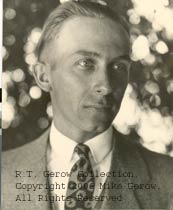|
Below, two aerial views of Long
Beach Airport taken by R.T.
Gerow in the course of his work with Continental Air Map.
Notice the airplane taking off in a cloud of dust near
the center of the image. Note also the storage tank, center
far right. In the original image, "Long
Beach" is
visible painted on the top. The superstructure of the tank
is visible behind the Continental Air Map hangar shown
here. That would
place the Continental Air Map hangar somewhere along the
line of buildings just right of center in the image below. Compare this line of buildings with the contemporary color image of the airport three photos below.
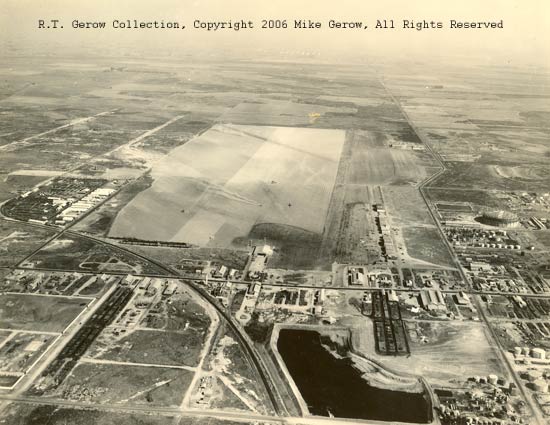 |
Below, a closer view of the field. What
looks like the same airplane trailing a cloud of dust is
actually a different craft. In the original images it is
possible to identify the airplane above as a biplane. The
airplane below is clearly a low-wing monoplane (see Pilot
O.C.
LeBoutillier for a conjecture about this airplane).
The pattern of automobiles on the ramp is very similar, indicating
the images were snapped in time very close together. The
lettering on the roof of the hangar says, "U.S.N.R." (United
States Navy Reserve). The three aircraft in rank at the top
of the hangar are Navy planes. On the original image you
can see star roundels on the wing tips. They appear to be
Curtiss Helldivers. This link and
this link provide
further information about the chronology of naval air base
locations in the Los Angeles area. You'll find our D-M pilot
Earl Daugherty mentioned
at these sites.
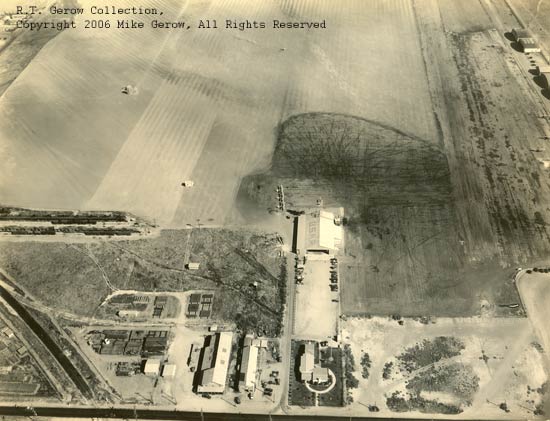 |
Below, an image of the Long Beach airport taken Mike Gerow March 20, 2008. The view is to the northeast at approximately 045 degrees. The long, right to left runway is 30/12. The expressway is Interstate 405. The old line of hangars illustrated in the top image on this page, was along the main runway to the right.
Long Beach Airport, March 20, 2008
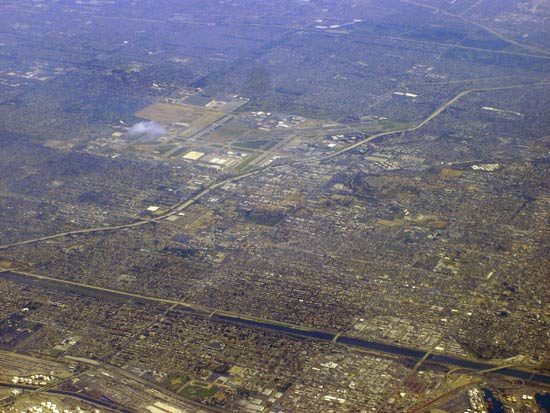 |
The oil derricks visible in this image were atop the green hilly park-like area (Signal Hill) just beyond the southern edge of the field. It appears to be a golf course today. The large storage tank would have been between that and the line of hangars. Follow the link to find directions to other images of the Long Beach Airport from different angles.
---o0o---
Image, below, of the Fresno,
CA Airport during the late
1920s probably captures the terrain during an early
afternoon in spring or fall (shadows from a low-latitude
sun). The blotches are actually standing water on the field.
On the back of the image is the Continental Air
Map Co. stamp giving its address as 114 South Beaudry,
Los Angeles, and the phone number: FAber 1705.
There appears to be a flurry of crowd activity in front
of the hangars, center left. That, and the number of aircraft
seeming to be in motion on the ground, suggest this may have
been a minor air meet of some kind, or a busy training/sight
seeing operation.
Fresno Airport, Late 1920s (probably late 1928)
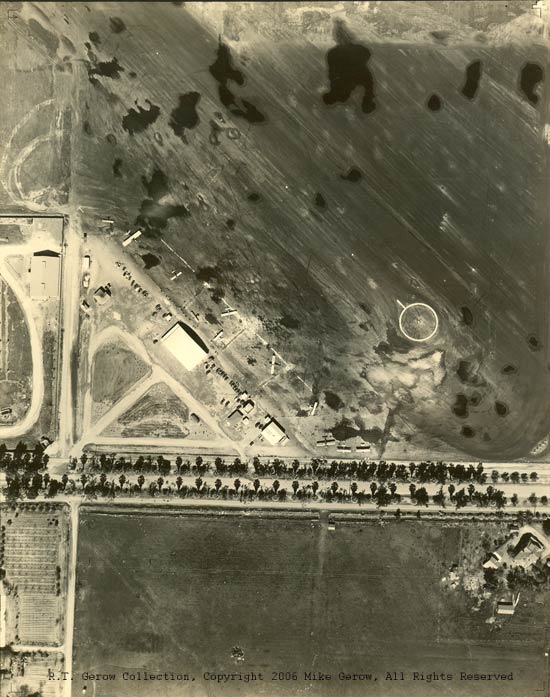 |
One amazing aspect of this image (don't forget,
were looking at aerial photographic technology ca. late 1920s)
is that in the original image the registration number of
at least one of the airplanes is visible on top of the wing.
Mike Gerow gets the credit for this detective
work (10x loupe). He asks us
to note the tree-lined White Bridge Road running across the
bottom third of the image. There are three airplanes northeast
and closest to White Bridge. The one on the left, slightly
askew from the others and closest to the building is a high-wing
monoplane. This is confirmed by looking at the shadows cast
by the wing compared to the two planes next to it which are
clearly biplanes. What follows is Mike's logic:
"With my loupe I can clearly read all but the last number
on the wing of the monoplane: NC 476...something. Unclear,
but definitely not a one. Went to Aerofiles and ran
all the registration numbers for the final numeral. Here's
what I found:
1. NC 4760 (Standard J-1)
2. NC 4761 (Waco GXE)
3. NC 4762 (Waco GXE)
4. NC 4763 (Fairchild FC-2)
5. NC 4764 (Fairchild FC-2)
6. NC 4765 (Travel Air 6000)
7. NC 4766 (Alexander Eagle Rock Combo-Wing)
8. NC 4767 (American Eagle A-1)
9. NC 4768 (American Eagle A-1)
10. NC 4769 (Lockheed Vega 5)
"Went back to Aerofiles and looked at pix of each type
to confirm that numbers 1, 2, 3, 7, 8 and 9 are bipes and
disqualified, leaving 4, 5, 6 and 10. It is clearly not a
Vega, leaving 4, 5, and 6.
"At this point I did some research on the FC-2 and Travel
Air 6000 to discern differences in their plan views. They
are quite similar looking in terms of the shape of their
wings, both rounded on the tips. But the shape of the horizontal
stabilizer clinched it, as betrayed by its shadow on
the ground.
"I found pix on the Internet of both the FC-2 and T A
6000. The FC-2 horiz tail has very rounded leading and trailing
edges. The Travel Air has a very rectangular constant-chord shape
that is clearly visible in the shadow on the ground.
"Conclusion: the plane in question has to be Travel Air
6000 (NC-4765). Ran the number on your site, and it came
up with pilot Walter
Beech who landed at D-M on 9/8/28
on route from Alamagordo to L.A. with passenger Owen Harned."
Q.E.D. Follow the link to Walter Beech for
an image of 4765 and the record of its Tucson landings in
September and October 1928. As the prototype Model 6000 you
will see it was registered NX. As a brand new model, its
presence on the west coast, flown by Beech and Travel Air
salesman Harned, could indeed be an advertising and marketing
voyage.
Introduced in early 1928 and billed as the
"Limousine of the Air", the trip was probably undertaken
to introduce the new airplane to the business community for
whom it was designed. Its presence on the west coast in the
fall of 1928 corroborates the shadow geometry in the image.
None of the other "476x" airplanes noted by Mike Gerow landed
at Tucson.
---o0o---
Below, two views of the aircraft carrier USS Lexington (CV-2).
Seven landings during 1931 and 1932 (in Navy Vought and Great
Lakes aircraft) at the Davis-Monthan
Airfield were made by pilots in whose home
base was identified as the USS Lexington.
The USS Saratoga (CV-3), like the Lexington, was also based
at San Diego,
CA. They joined the Battle Fleet based
at San Pedro, next door to Long Beach, in April 1928. Fourteen
pilots from the Saratoga landed at Tucson between 1929 and
1932.
The way
to tell the difference between the two carriers is by their
funnel stripes. CV-2 had a black horizontal band at the top
of its funnel, and CV-3 sported a wide vertical black stripe
down the middle of its funnel. CV-2 was lost during the 1942
Battle of the Coral Sea. (CV-3 went down during the July
1946 A-bomb tests at Bikini Atoll.)
Aircraft Carrier USS Lexington
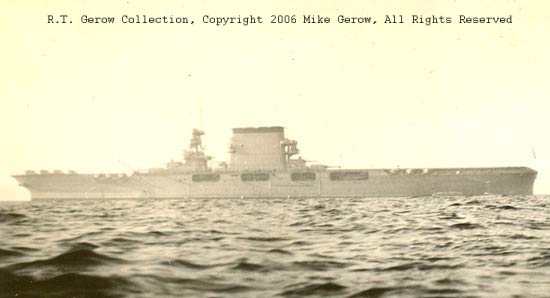 |
USS Lexington
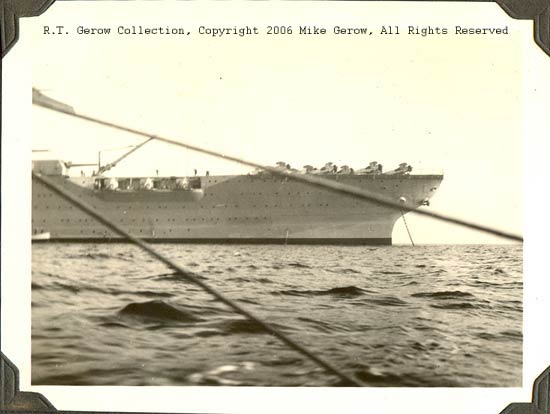 |
For more information and many images
of the USS Lexington (as well as a few of the USS Saratoga)
see this link.
---o0o---
THIS PAGE UPLOADED: 11/16/06 REVISED: 11/19/06, 03/26/08
|

